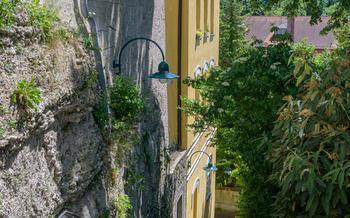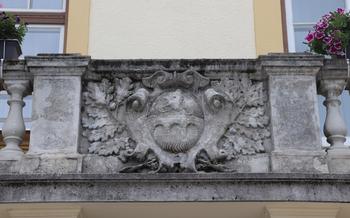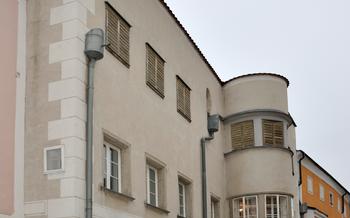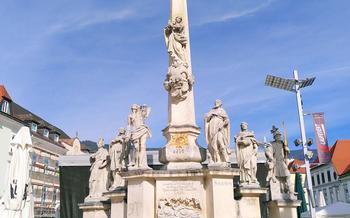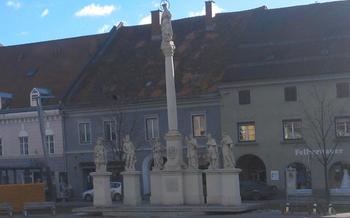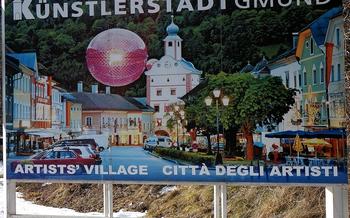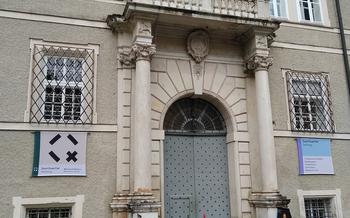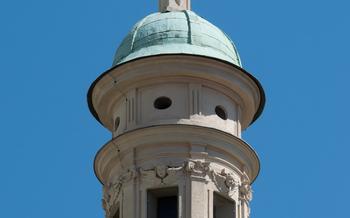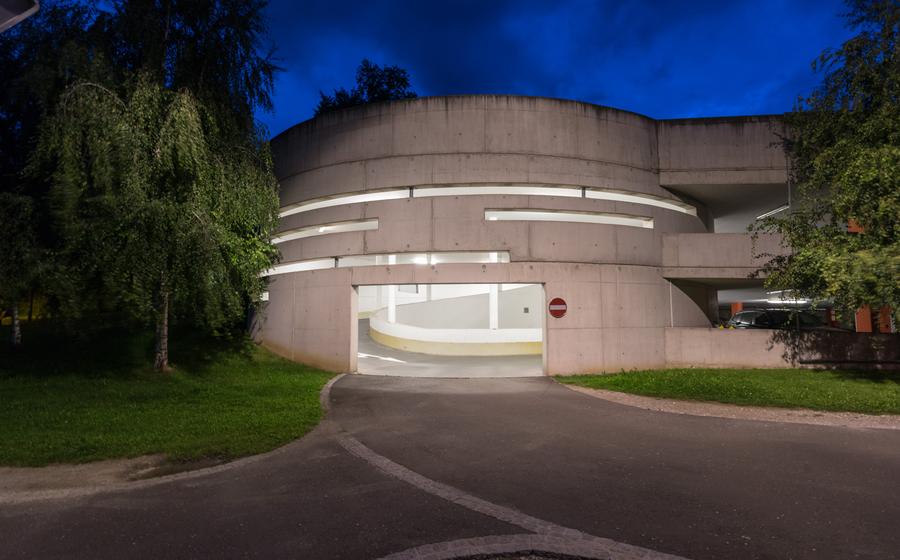
Benedictine Monastery in Admont
- Benedictine Monastery Admont: A Timeless Masterpiece
- Marveling at the Frescoes: A Visual Feast
- Uncovering the Secrets of the Scriptorium
- Admiring the Artistic Treasures: Masterpieces Abound
- Strolling Through the Gardens: A Sanctuary of Nature
- Learning About the Monastery's History: A Living Legacy
- Attending a Concert or Event: Cultural Delights
- Indulging in Local Cuisine: Culinary Delights
- Exploring the Surrounding Area: Natural Wonders
- Visiting the Nearby Attractions: Historical and Cultural Gems
- Planning Your Visit: Practical Information
- Respecting the Monastery's Sanctity: Etiquette and Behavior
- Engaging with the Monks: A Dialogue of Faith and Culture
- Insider Tip: Unveiling Hidden Gems
Benedictine Monastery Admont: A Timeless Masterpiece
Benedictine Monastery Admont, nestled in the picturesque Enns Valley of Austria, stands as a testament to the enduring power of faith, architecture, and scholarship. Founded in 1074 by Archbishop Gebhard of Salzburg, the monastery has played a pivotal role in the religious, cultural, and intellectual landscape of Austria for over nine centuries.
The architectural ensemble of Admont Abbey is a masterpiece of Romanesque and Baroque styles, harmoniously blending the grandeur of medieval design with the elegance of later periods. The imposing basilica, with its towering spires, intricate carvings, and stained-glass windows, dominates the skyline of the town of Admont.
Within the monastery's walls lies one of its most celebrated treasures: the Admont Library. This awe-inspiring hall, adorned with exquisite ceiling frescoes and lined with floor-to-ceiling bookcases, houses a collection of over 200,000 volumes, including rare manuscripts, incunabula, and medieval codices. The library's significance extends far beyond its impressive size, earning it a place on the UNESCO World Heritage List as one of the oldest and most important monastic libraries in the world.
Marveling at the Frescoes: A Visual Feast
The interior of the library hall is further adorned with stunning ceiling frescoes that depict biblical scenes and historical events. These magnificent artworks were created by renowned artists such as Martino Altomonte and Joseph Adam Mölk, and they serve as a testament to the monastery's rich artistic heritage.
The frescoes are not merely decorative; they carry profound symbolic and allegorical meanings, inviting viewers to contemplate the deeper truths and lessons embedded within the imagery. The scenes depicted range from the creation of the world to the life of Christ, and they are arranged in a way that guides the viewer's gaze and encourages contemplation.
In recent years, the frescoes have undergone a meticulous restoration process that has brought them back to their former glory. This painstaking work involved cleaning, repairing, and retouching the delicate paintings, ensuring that they can be enjoyed and appreciated by future generations.
As you stand in the library hall, surrounded by these awe-inspiring frescoes, you can't help but feel a sense of wonder and admiration. The beauty and intricacy of the artwork transport you back in time, offering a glimpse into the minds and hearts of the monks who created them.
Uncovering the Secrets of the Scriptorium
The Benedictine Monastery in Admont alberga a fascinating scriptorium, a room dedicated to the production of manuscripts during the Middle Ages. This scriptorium played a crucial role in preserving and transmitting knowledge, serving as a hub for the creation of intricate and beautifully illuminated manuscripts.
In the scriptorium, monks meticulously copied and illustrated texts, ranging from religious scriptures to scientific treatises. Using quills and ink, they meticulously transcribed words onto parchment, creating works of art that showcased their exceptional skill and devotion. The monks' dedication to preserving knowledge ensured that valuable texts were passed down through the centuries, contributing to the intellectual and cultural development of Europe.
Visitors to the Admont Monastery can explore the scriptorium and learn about the techniques and materials used by the monks. They can marvel at the intricacy of the illuminated manuscripts, with their vibrant colors, gold leaf embellishments, and ornate calligraphy. These manuscripts are a testament to the monks' artistic talents and their commitment to preserving knowledge for future generations.
The scriptorium at Admont Monastery is a unique and inspiring place that offers a glimpse into the world of medieval scholarship. It serves as a reminder of the importance of preserving and transmitting knowledge, and the enduring legacy of the Benedictine monks who dedicated their lives to this pursuit.
Admiring the Artistic Treasures: Masterpieces Abound
The Benedictine Monastery in Admont houses an impressive collection of paintings, sculptures, and other artworks that are a testament to the monastery's rich artistic heritage. Among the highlights are works by renowned artists such as Tintoretto, Rembrandt, and Lucas Cranach the Elder. The thematic and stylistic diversity of the artworks reflects different periods and influences, from the Gothic to the Baroque.
One of the most notable artworks is the "Admont Altarpiece" by Michael Pacher, a masterpiece of late Gothic art. The altarpiece depicts scenes from the life of Christ and is renowned for its intricate carvings and vibrant colors. Another highlight is the "Martyrdom of St. Catherine" by Tintoretto, a powerful and moving portrayal of the saint's suffering.
The monastery's collection also includes a number of sculptures, including a beautiful wooden Madonna and Child from the 15th century. The sculptures are often placed in niches throughout the monastery, creating a sense of intimacy and devotion.
Each artwork in the Benedictine Monastery Admont has its own story to tell, and visitors are encouraged to take their time to explore the collection and discover the hidden treasures that it holds.
Strolling Through the Gardens: A Sanctuary of Nature
Surrounding the Benedictine Monastery in Admont is a stunning expanse of beautifully landscaped gardens, offering visitors a tranquil oasis of nature and tranquility. Stroll through the meticulously manicured grounds and discover a vibrant tapestry of plants and flowers, each contributing to the serene atmosphere. The gardens, with their carefully chosen flora, serve as a sanctuary for contemplation and relaxation.
Let your senses be captivated by the symphony of colors and fragrances as you explore the diverse array of plant life. Marvel at the vibrant hues of roses, the delicate beauty of lilies, and the cheerful blooms of daisies. Breathe in the invigorating scent of lavender, the sweet aroma of jasmine, and the heady fragrance of honeysuckle.
Beyond their aesthetic appeal, the plants in the gardens hold symbolic and medicinal significance. Discover the healing properties of herbs like chamomile, mint, and sage, which have been used for centuries to alleviate ailments and promote well-being. Admire the symbolic meanings associated with certain flowers, such as the purity represented by white lilies and the passion symbolized by red roses.
As you wander through the gardens, take a moment to sit beneath the shade of a towering tree, allowing the gentle rustling of leaves to lull you into a state of tranquility. Let the worries of the world melt away as you immerse yourself in the beauty of nature, finding solace and inspiration in this serene sanctuary.
Learning About the Monastery's History: A Living Legacy
The Benedictine Monastery in Admont has a rich and fascinating history that spans over a millennium. Founded in 1074 by Archbishop Gebhard of Salzburg, the monastery has played a pivotal role in the religious, cultural, and intellectual life of the region. Over the centuries, it has undergone numerous transformations and expansions, reflecting the changing needs and circumstances of its time.
During the Middle Ages, Admont flourished as a center of learning and scholarship. Its scriptorium produced exquisite manuscripts, many of which are still preserved in the monastery's library. The monastery also played an important role in the Gregorian Reform movement, which sought to reform the Catholic Church and strengthen papal authority.
In the 16th century, the monastery was severely damaged during the Protestant Reformation. However, it was later rebuilt and restored to its former glory under the patronage of the Habsburg emperors. In the 18th century, the monastery underwent a major Baroque renovation, which resulted in the construction of the magnificent library hall and the addition of numerous frescoes and artworks.
The 19th century brought further challenges to the monastery, as it was forced to adapt to the changing political and social landscape of Austria. Despite these challenges, the monks continued to uphold their traditions and preserve their cultural heritage. In the 20th century, the monastery underwent a period of renewal and restoration, which saw the establishment of a museum and the digitization of the library's collection.
Today, the Benedictine Monastery in Admont stands as a testament to the enduring legacy of Benedictine monasticism. It continues to be a place of prayer, study, and cultural preservation, while also welcoming visitors from around the world to experience its rich history and stunning beauty.
Attending a Concert or Event: Cultural Delights
The Benedictine Monastery in Admont is not only a religious and historical treasure but also a vibrant center for arts and culture. The monastery's active involvement in promoting cultural events offers visitors a unique opportunity to experience the monastery's rich heritage through music, art, and performances.
Throughout the year, the monastery hosts a variety of concerts, exhibitions, and other cultural events that showcase the talents of local and international artists. From classical music concerts to contemporary art exhibitions, there is something for everyone to enjoy.
Attending a concert or event in the monastery is a truly special experience. The historic setting, with its stunning architecture and acoustics, creates a unique and intimate atmosphere that enhances the performance. Visitors can immerse themselves in the beauty of the surroundings while enjoying world-class cultural entertainment.
In addition to the regular events, the monastery also hosts special concerts and performances during the summer months. These events often feature renowned musicians and performers from around the world, attracting music lovers from far and wide.
Whether you are a fan of classical music, contemporary art, or simply enjoy experiencing culture in a unique setting, attending a concert or event at the Benedictine Monastery in Admont is an unforgettable experience. Be sure to check the monastery's website or contact the tourist information office for information on upcoming events.
Indulging in Local Cuisine: Culinary Delights
A visit to the Benedictine Monastery in Admont is not complete without savoring the culinary delights offered by its restaurant. Step into a world of traditional Austrian cuisine, where fresh, local ingredients and time-honored recipes come together to create a symphony of flavors.
The monastery's restaurant, with its warm ambiance and attentive service, invites you to embark on a culinary journey through the region's rich gastronomic heritage. Begin your meal with a hearty bowl of Styrian pumpkin seed soup, a local specialty that bursts with nutty flavors and the essence of Styria.
For the main course, indulge in a classic Wiener Schnitzel, a golden-fried cutlet made with the finest veal, accompanied by a tangy potato salad and a side of tart lingonberry jam. Alternatively, savor the mouthwatering Tafelspitz, a boiled beef dish served with horseradish sauce, roasted potatoes, and sautéed spinach, a testament to the region's love for hearty and comforting dishes.
No Austrian meal is complete without a sweet ending. Treat yourself to a slice of the famous apple strudel, a flaky pastry filled with tender apples, cinnamon, and raisins, served warm with a dollop of vanilla sauce. Alternatively, opt for the Salzburger Nockerl, a sweet soufflé-like dessert made with egg whites, sugar, and powdered sugar, creating a fluffy and ethereal treat that will leave you craving for more.
As you savor the monastery's culinary offerings, let the historic ambiance transport you back in time. Imagine the monks of old, gathering in the same halls, their conversations filled with laughter and the clinking of glasses, as they celebrated the fruits of their labor and the bounty of the land. Indulge in the local cuisine at the Benedictine Monastery in Admont, and experience a taste of Austrian tradition, hospitality, and culinary excellence.
Exploring the Surrounding Area: Natural Wonders
Beyond the walls of the Benedictine Monastery Admont, the breathtaking natural beauty of the Enns Valley and the Gesäuse National Park beckons outdoor enthusiasts and nature lovers alike. Verdant meadows, towering mountains, and crystal-clear rivers create a picturesque landscape that invites exploration.
Lace-up your hiking boots and embark on a journey through the Enns Valley, following scenic trails that wind through lush forests and past cascading waterfalls. Ascend to panoramic viewpoints, where breathtaking vistas of the surrounding peaks and valleys await. Capture the essence of this alpine paradise with your camera, immortalizing memories amidst nature's splendor.
For those seeking a more challenging adventure, the Gesäuse National Park offers a rugged wilderness playground. Traverse rugged terrain, marveling at towering rock faces and pristine alpine lakes. Hike to the summit of the Hochtor, the park's highest peak, and be rewarded with unparalleled views that stretch for miles.
Embrace the thrill of mountain biking, pedaling along winding trails that traverse forests and meadows, offering a unique perspective of the region's natural beauty. In winter, the snow-capped peaks transform into a skier's paradise, with slopes suitable for all levels of expertise.
Venture beyond the monastery's immediate surroundings and discover the charm of nearby towns and villages, each with its own unique character and stories to tell. Explore the medieval streets of Leoben, with its historic buildings and monuments, or delve into the region's mining heritage at the Eisenerz Mining Museum.
Allow yourself to be captivated by the natural wonders that surround the Benedictine Monastery Admont. Whether you prefer leisurely strolls through picturesque valleys, challenging hikes through alpine terrain, or exhilarating bike rides, this region offers a sanctuary for nature enthusiasts and adventure seekers alike.
Visiting the Nearby Attractions: Historical and Cultural Gems
Beyond the monastery itself, the surrounding area offers a wealth of historical and cultural attractions that enhance the experience of visiting Admont. The medieval town of Leoben, just a short drive away, boasts a charming historic center adorned with Gothic and Renaissance architecture. Visitors can explore the town's main square, with its imposing town hall, and wander through the narrow streets lined with colorful buildings.
The Eisenerz Mining Museum, located in the nearby town of Eisenerz, delves into the region's rich mining heritage. Visitors can learn about the history of iron mining in the area, which dates back to the Middle Ages, and explore the museum's exhibits, which include mining equipment, minerals, and geological specimens.
The Göss Abbey, another impressive Benedictine monastery situated in the vicinity of Admont, is a testament to the region's strong religious traditions. Founded in the 11th century, Göss Abbey features a beautiful Romanesque-Gothic church, a cloister with intricate carvings, and a museum showcasing the monastery's history and art collection.
Combining a visit to Admont with these nearby attractions provides a comprehensive cultural and historical experience, allowing visitors to immerse themselves in the region's rich heritage and diverse attractions.
Planning Your Visit: Practical Information
Opening Hours and Admission:
The Benedictine Monastery Admont is open to visitors from Tuesday to Sunday, with varying hours depending on the season. Check the monastery's official website for the most up-to-date information on opening times. Admission fees apply for both the monastery and the library, with reduced rates for students, seniors, and families. Guided tours are available at an additional cost and are highly recommended for a more immersive experience.
Accessibility:
The monastery is committed to providing an accessible environment for all visitors. Wheelchair ramps and elevators are available to ensure that all areas of the complex are accessible to visitors with disabilities. Guided tours can also be adapted to accommodate the needs of visitors with disabilities.
Photography and Videography:
Photography and videography are permitted in most areas of the monastery, but flash photography is prohibited to protect the delicate artifacts and manuscripts. Tripod use is also restricted in certain areas. Please be respectful of the monks and other visitors when taking photos and videos.
Getting There and Parking:
The monastery is easily accessible by car or public transportation. If you're driving, ample parking is available near the monastery. Public transportation options include buses and trains, with stops within walking distance of the monastery. Plan your journey in advance to avoid any inconvenience.
Additional Tips:
-
Dress appropriately when visiting the monastery, especially when entering the church or library.
-
Be mindful of the noise level and avoid talking loudly or disturbing other visitors.
-
Respect the privacy of the monks and their daily routines.
-
Purchase a souvenir or make a donation to support the monastery's ongoing preservation efforts.
Respecting the Monastery's Sanctity: Etiquette and Behavior
When visiting the Benedictine Monastery in Admont, it is essential to be mindful of its sacred nature and observe appropriate etiquette and behavior. Visitors are expected to maintain a respectful and quiet atmosphere, particularly in the library and other sacred spaces. Disruptive activities, such as loud conversations or running, are not permitted.
It is important to dress modestly and avoid wearing revealing or inappropriate clothing. Visitors should be respectful of the monks' privacy and avoid entering restricted areas or disturbing them during their daily activities. When encountering a monk, a polite greeting and a respectful demeanor are appropriate.
To fully immerse oneself in the monastery's spiritual atmosphere, visitors can attend religious services or join guided tours led by the monks. These experiences offer a unique opportunity to gain insights into the Benedictine way of life and the monks' commitment to their faith. Visitors are encouraged to ask questions and engage in respectful and open-minded dialogue, fostering a deeper understanding of monastic life.
By adhering to these guidelines, visitors can contribute to preserving the monastery's sacredness and ensure a meaningful and enriching experience for all.
Engaging with the Monks: A Dialogue of Faith and Culture
The Benedictine Monastery in Admont offers visitors the remarkable opportunity to engage with the monks and delve into the depths of their faith and culture. Attending religious services, such as the daily Mass or Vespers, provides an immersive experience into the monks' spiritual practices and the Benedictine way of life. Guided tours led by the monks themselves offer unique insights into the history, traditions, and daily routines of the monastery.
Visitors are encouraged to ask questions and engage in respectful and open-minded dialogue with the monks. This interaction fosters a deeper understanding of monastic life, its challenges, and its profound spiritual rewards. The monks are dedicated to sharing their faith and insights with visitors, creating a meaningful exchange of ideas and perspectives.
Through these encounters, visitors gain a glimpse into the rich tapestry of Benedictine spirituality, founded on the principles of prayer, work, and community. The monks' commitment to their faith, their dedication to preserving cultural heritage, and their pursuit of knowledge inspire visitors and leave a lasting impact long after their visit to Admont.
Insider Tip: Unveiling Hidden Gems
Beyond the main attractions of the Benedictine Monastery Admont, there are hidden gems waiting to be discovered by curious visitors. Explore the monastery's secret passages and hidden rooms, uncovering fascinating stories of the past. Each passageway and chamber holds its own unique narrative, transporting visitors back in time. Join a guided tour to delve deeper into these hidden corners and learn about the monastery's rich history.
The monastery also houses a unique collection of musical instruments, carefully preserved in the music archive. Discover rare and beautiful instruments, from ancient lutes to ornate harpsichords. Take advantage of special events and concerts held in the monastery, where talented musicians bring these instruments to life, filling the historic halls with enchanting melodies.
For a truly authentic experience, attend a traditional Austrian "Heurigen" wine tasting event in the monastery's atmospheric cellars. Immerse yourself in the local culture as you sample delicious regional wines, accompanied by traditional Austrian cuisine. Enjoy live music and lively conversations with fellow wine enthusiasts, creating memories that will last a lifetime.
To capture the monastery's beauty from unique perspectives, seek out the best viewpoints for photography. Climb the winding stairs to the monastery's tower for breathtaking panoramic views of the surrounding countryside. Explore the gardens and courtyards to find hidden nooks that offer stunning compositions. Whether you're an amateur photographer or a seasoned pro, the monastery provides endless opportunities to capture its essence through your lens.
